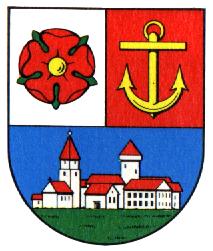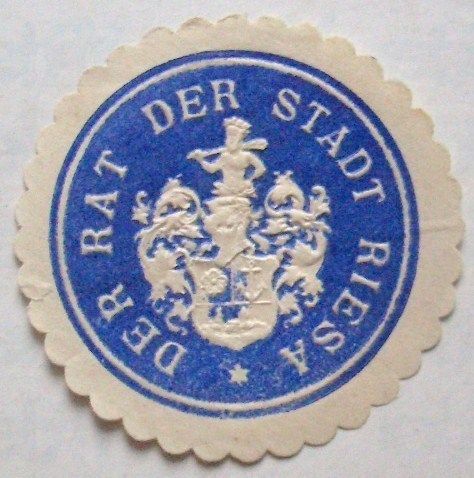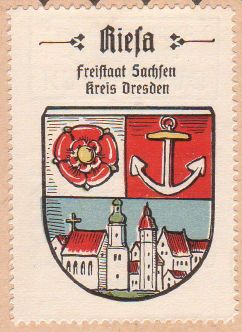Riesa: Difference between revisions
Jump to navigation
Jump to search
Knorrepoes (talk | contribs) No edit summary |
Knorrepoes (talk | contribs) No edit summary |
||
| Line 15: | Line 15: | ||
'''Origin/meaning :'''<br/> | '''Origin/meaning :'''<br/> | ||
The lower half shows a view of the city, which includes the local castle. The castle belonged until 1873 to the Lords of Welck. The rose is taken from their arms. The anchor signifies the importance of shipping on the Elbe. | The lower half shows a view of the city, which includes the local castle. The castle belonged until 1873 to the Lords of Welck. The rose is taken from their arms. The anchor signifies the importance of shipping on the Elbe. | ||
Around 1900 the city also used a canting giant (Riese) as a crest. | |||
{|align="center" | {|align="center" | ||
| Line 21: | Line 23: | ||
|} | |} | ||
[[Literature]] : Hupp, O: [[Kaffee Hag albums]], 1920s; Benzing et al, 1984 | [[Literature]] : Hupp, O: [[Kaffee Hag albums]], 1920s; Benzing et al, 1984 | ||
Revision as of 09:18, 13 November 2011
| Heraldry of the World Civic heraldry of Germany - Deutsche Wappen (Gemeindewappen/Kreiswappen) |
RIESA
State : Sachsen
District (Kreis) : Meissen (until 2008 Riesa-Grossenhain)
Additions : 1923 Gröba, Weida; 1925 Merzdorf ; 1950 Pausitz, Poppitz; 1961 Mergendorf ; 1974 Canitz, Pochra; 1994 Jahnishausen, Mautitz, Nickritz; 1996 Leutewitz
Origin/meaning :
The lower half shows a view of the city, which includes the local castle. The castle belonged until 1873 to the Lords of Welck. The rose is taken from their arms. The anchor signifies the importance of shipping on the Elbe.
Around 1900 the city also used a canting giant (Riese) as a crest.
| The seal of the city around 1900 |
The arms in the Kaffee Hag albums +/- 1925 |
Literature : Hupp, O: Kaffee Hag albums, 1920s; Benzing et al, 1984



